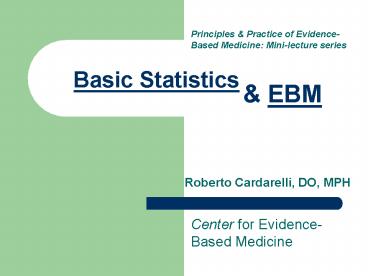Basic Statistics - PowerPoint PPT Presentation
1 / 18
Title:
Basic Statistics
Description:
Principles & Practice of Evidence-Based Medicine: Mini-lecture series & EBM ... examples: average daily fat intake and incidence of breast cancer. ... – PowerPoint PPT presentation
Number of Views:115
Avg rating:3.0/5.0
Title: Basic Statistics
1
Basic Statistics
Principles Practice of Evidence-Based Medicine
Mini-lecture series
EBM
- Roberto Cardarelli, DO, MPH
Center for Evidence-Based Medicine
2
(No Transcript)
3
(No Transcript)
4
Why we have statistics?
- Descriptive Statistics
- identify patterns
- leads to hypothesis generating
- Inferential Statistics
- distinguish true differences from
- random variation
- allows hypothesis testing
5
Descriptive studies
6
Describing Data with Numbers
- Measures of Central Tendency
- MEAN -- average
- MEDIAN -- middle value
- MODE -- most frequently observed
value(s) - Measures of Dispersion
- RANGE - highest to lowest values
- STANDARD DEVIATION - how closely do values
cluster around the mean value - SKEWNESS - symmetry of curve
7
The Normal Distribution
- Mean median mode
- Skew is zero
- 68 of values fall between 1 SD
- 95 of values fall between 2 SDs
Mean, Median, Mode
1?
2?
8
Inferential Statistics
- Used to determine the likelihood that a
conclusion based on data from a sample is true
9
Terms
- p value the probability that an observed
difference could have occurred by chance. - The significance is determined by alpha
- Confidence interval the range of values we can
be reasonably certain includes the true value.
10
Types of Errors
Truth
Conclusion
Power 1-?
11
Statistical Tests
- Two types of variables
- Dichotomous (sex, race, etc.)
- Continuous (age, BP, etc.)
- chi-square two dichotomous variables
- example deaths from bike accidents depending on
helmet use between two time intervals. - t-test one continuous and one dichotomous
- example difference in mean birth weights between
males and females - correlation coefficient two continuous
variables - examples average daily fat intake and incidence
of breast cancer. - meta-analysis a statistical method used to
combine results of several studies into a single
study.
12
Statistics and EBM
- We want terms that makes sense to clinicians.
- Easy to apply to patients
- Easy to explain to patients
- Differentiate what is true and not true
- We want clinically important information
13
Articles of Diagnosiswell learn
- Sensitivity - the proportion of people with
disease who have a positive test. - Specificity - the proportion of people free of a
disease who have a negative test. - Likelihood Ratio - the likelihood that a given
test result would be expected in a patient with
the target disorder compared to the likelihood
that the same result would be expected in a
patient without that disorder. - Negative Predictive Value (-PV) - the proportion
of people with a negative test who are free of
disease. - Positive Predictive Value (PV) - the proportion
of people with a positive test who have disease.
14
Articles of Prognosiswell learn
- Survival rates
- Example 1 or 5-year survival rates.
- Median survivals
- Example length of follow-up by which 50 have
died. - Survival curves
- Example At each point in time, the proportion of
the study sample who do not have the outcome
(death).
15
Example Survival curve
16
Articles on Therapywell learn
- Absolute Risk Reduction (ARR) - The difference in
the event rate between control group (CER) and
treated group (EER. - ARR CER - EER.
- Relative Risk Reduction (RRR) - The percent
reduction in events in the treated group event
rate (EER) compared to the control group event
rate (CER) - RRR (CER - EER) / CER 100
- Number Needed to Treat (NNT) - The number of
patients who need to be treated to prevent one
bad outcome. It is the inverse of the ARR. - NNT 1/ARR.
17
Articles on Harmwell learn
- Odds ratio - describes the odds of an
experimental patient suffering an adverse event
relative to a control patient. - Risk Ratio - The ratio of risk in the treated
group (EER) to the risk in the control group. - (CER)RR EER/CER.
- RR is used in randomized trials and cohort
studies. - Number Needed to Harm (NNH) is the number of
patients who need to be exposed to cause one
additional harmful event.
18
Next class
- Start the good stuff
- Diagnosis and screening
- DOES ANYONE WANT TO BRING IN AN ARTICLE ON
DIAGNOSIS? - 1st 30 minutes Lecture
- 2nd 30 minutes Appraise the article

